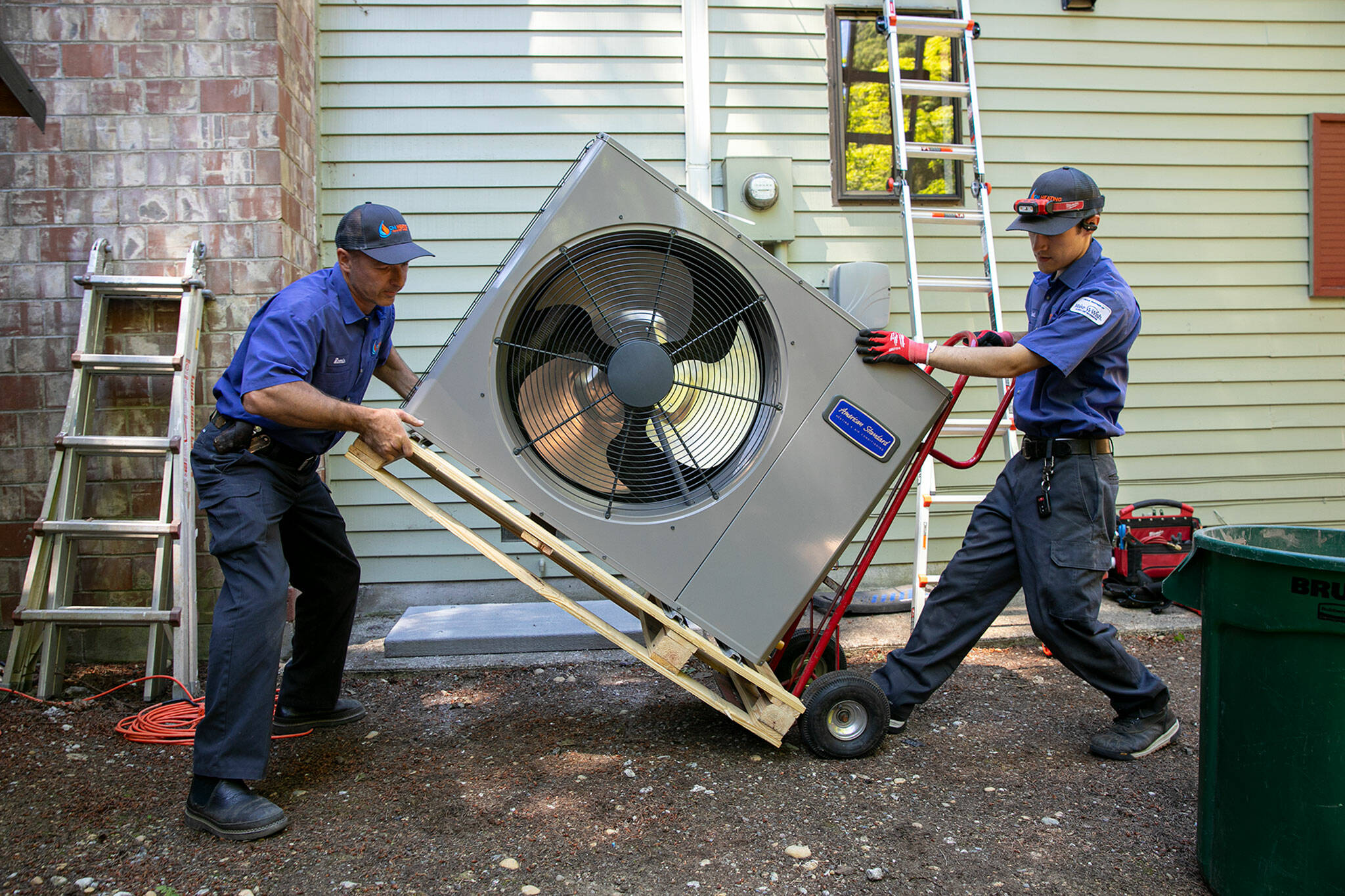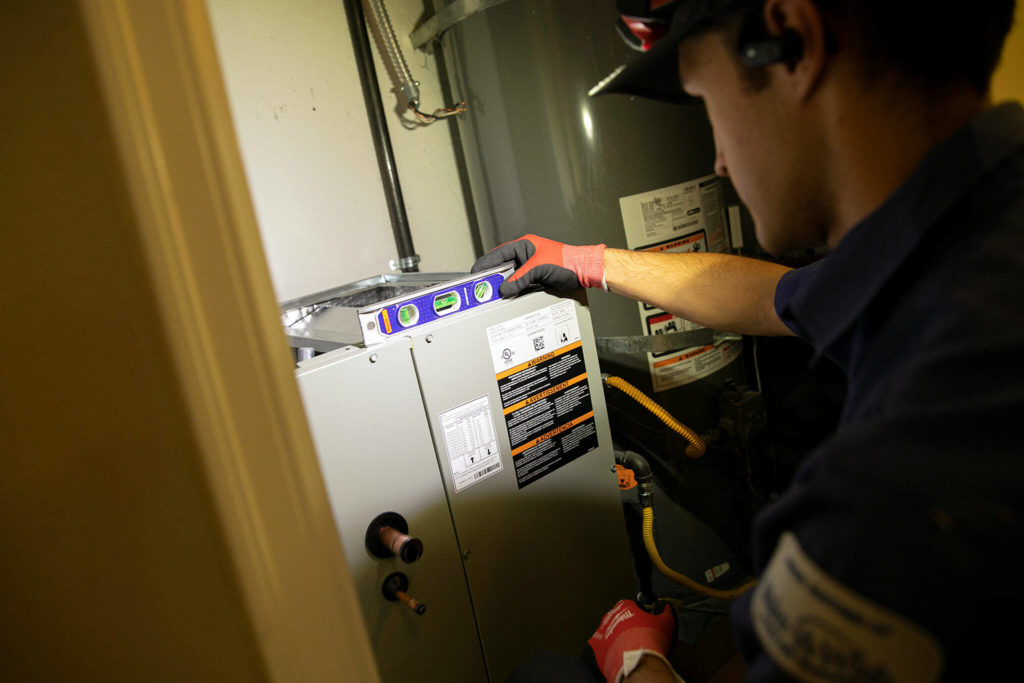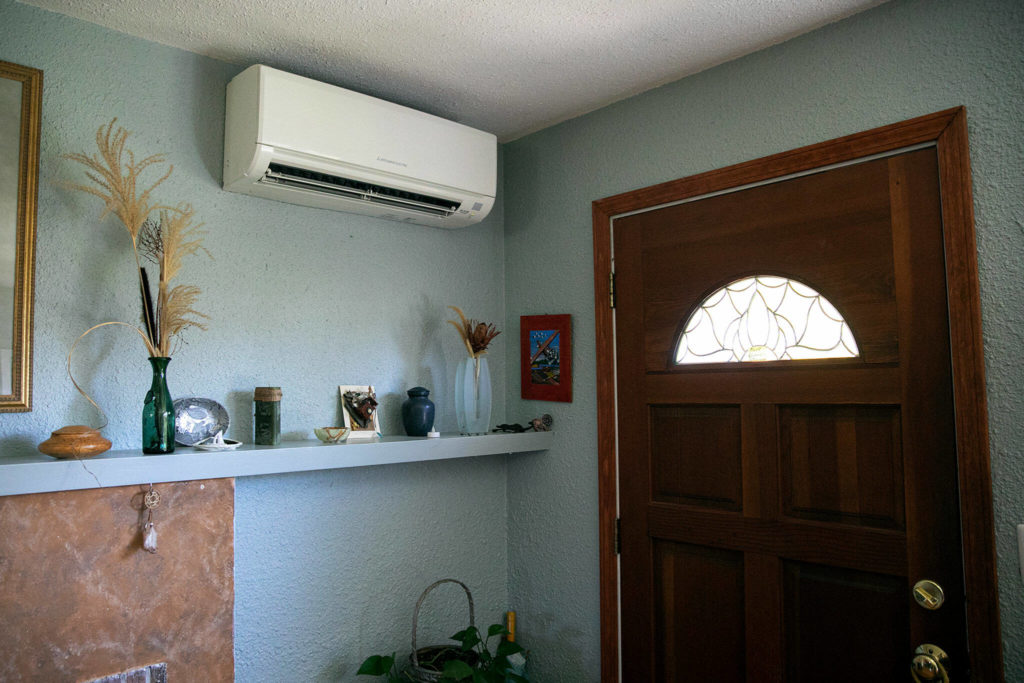When Julie Langabeer and her late husband bought a 1925 Craftsman-style home in North Everett, they replaced its heating sources — a scary-to-light gas fireplace and ancient wall heaters — with a gas furnace. That was 12 years ago.
“At the time it didn’t occur to me not to have gas. Climate change wasn’t foremost on my brain at that point,” Langabeer said. “Now I feel guilty every time the thing runs.”
This fall, the retiree is having the far-from-old furnace replaced with an electric heat pump. The natural gas line to the house will come out.
While the gas industry describes heat pumps as “not a silver bullet,” many do consider them a major weapon in the battle to reduce greenhouse gas emissions. Heat pumps not only provide efficient space heating but double as air conditioners, because they can transfer warm air in either direction. They offer protection against heat waves and allow Pacific Northwesterners to close their windows and breathe filtered air when forest fire smoke invades the region.
It isn’t common for homeowners to ditch gas entirely, but Langabeer’s heat pump purchase is an increasingly popular one. And policy is moving that way. The Washington State Building Code Council is expected to approve proposals requiring heat pumps for space and water heating for new residential construction.
Climate activists were hoping the council would ban gas altogether in new homes, as it has done for future commercial buildings.
“The fastest rising source of emissions is our built environment,” said Kelly Hall, Washington state director of Climate Solutions, adding it only makes sense to stop building homes that use fossil fuels. “We cannot continue to dig the hole deeper.”
If given final approval in November, the new residential codes will take effect in July 2023, the same as the commercial building gas ban. Both changes align with state statutes that call for progressive action to reduce emissions by 2031.
The Northwest Gas Association, which represents six utilities and four pipeline companies, objects to policies that promote or require all-electric buildings.
“We get the need for climate action,” said Executive Director Dan Kirschner, but not the push to “go down one path at the expense of another.” Reducing or limiting the number of customers will increase fuel costs for those still using gas, he said.
“Our members are thinking about the impact on their customers, believe it or not,” he said.
Washington state has a 45,000-mile natural gas delivery system, Kirschner added. And those pipes can carry “renewable natural gas” such as the methane captured at landfills, which he said is potentially 5% of the total gas supply. The pipes might also someday carry liquid hydrogen, a carbon-free alternative that shows the most promise as a transportation fuel.
The methane problem
An estimated 40% of U.S. greenhouse gas emissions is attributed to buildings, and half of home energy demand is for space and water heating. While some homes still use oil or propane, most fossil fuel heating is generated by less expensive natural gas. The adjective “natural” originally meant it came straight from underground deposits of decayed organic matter, with no chemical additives.
The gas piped into homes is mostly methane, which is blamed for a third of human-caused climate change. It is 80 times more potent than carbon dioxide. According to a new analysis, methane releases are increasing worldwide, even though 110 countries pledged to reduce emissions by 30% by 2030.
Methane is released into the atmosphere during the production, processing and distribution of gas, as well as from abandoned wells. Most of Washington’s supply comes from drilling operations in British Columbia and Colorado.
Washington’s bountiful supply of carbon-free hydropower makes the move away from residential use of gas a logical choice here, said Sean Denniston of the New Buildings Institute, a Portland-based nonprofit.
“Electrification isn’t always decarbonization,” he said. “In Washington, it’s a slam-dunk choice.”
Denniston wrote the three residential code proposals considered this year by the Building Code Council. As submitted, the first would have banned gas entirely from new residential construction. In June, the council’s technical advisory group denied that one, so it won’t go forward for full council approval. The second would have required electric heat pumps for space heating, the third electric heat pumps for water heaters. Those were approved but amended to allow for gas heat pumps, which aren’t yet widely available for home use.
Among those opposing the all-electric push is Puget Sound Energy. It is a regional purveyor of gas and electricity, though it provides only gas to Snohomish County customers. They buy power from the county’s Public Utility District. PSE has set what it calls an aspirational goal to reach net zero carbon emissions for natural gas sales by 2045 — customer use in homes and businesses — with an interim target of a 30% emissions reduction by 2030.
How do you decarbonize a fossil fuel company?
“That’s a good question,” said Josh Jacobs, PSE’s vice president of clean energy strategy. “We don’t have all the answers and there’s a lot of work ahead of us.”
Strategies identified so far include repairing leaks in the distribution system, emphasizing energy efficiency, and giving customers incentives to reduce their use of gas. The company also envisions greater use of renewable natural gas. So far, it is buying methane captured at a Klickitat County landfill, and offering customers the chance to get a credit on their fuel bills if they pay $5 monthly to support the project.
Gas helps get the region through peak winter demand on the power supply, Jacobs notes. He questions whether there will be enough power available if customers give up gas heat.
At Snohomish PUD, Garrison Marr, senior power supply manager, is more concerned about providing enough energy for the growing number of electric vehicle chargers.
“To the extent we’re sweating it, we’re sweating at a four-to-1 ratio over EVs,” Marr said.
Weighing costs to pocketbooks and planet
Jacobs foresees many customers settling on a hybrid heating option, with a gas furnace that kicks in when temperatures get too cold for some electric heat pumps to handle. Or they could buy heat pumps in lieu of air conditioning, which might happen at his own Snohomish house. “We’ve gone back and forth” on how to stay cool, he said.
He also raises two common concerns about heat pumps: noisy units and that extreme cold-weather limitation. Such talk frustrates Denniston, who said even contractors often don’t realize how much heat pump technology has improved in recent years.
As with all things mechanical, you get what you pay for. Less expensive units work fine until it’s nearly freezing outside. Higher-end units will keep a house cozy at much colder temperatures.
Langabeer paid extra for a more efficient, quieter unit. It will cost her $20,000, including a new electric backup furnace. Her heat pump shopping started at the Snohomish PUD website, where she found a list of contractors and got three estimates. She didn’t qualify for a PUD $1,500 to $2,500 rebate, which are available only for customers who replace an electric furnace with a heat pump.
Hall, the Climate Solutions director, said the state needs to start incentivizing the conversion from gas to electric heat pumps. One way to do that would be to use money from the state’s Climate Commitment Act, which in 2023 will start generating revenue from some of the largest greenhouse gas-emitting sources and industries.
“The vast majority of those funds are not spoken for, and it will be a big topic in the Legislature next year,” Hall said.
Julie Martinson, a member of the 350.org climate action group, also hopes that state or federal money, such as COVID relief funds, can be used to help low-income people buy heat pumps. After all, she reasons, air pollution and smoke aggravate health conditions such as her asthma and her late husband’s lung problems.
In 2012, Martinson and her husband bought a $7,000 heat pump, financed through a Snohomish PUD loan, after she tired of hauling bags of woodstove pellets into their Everett house.
“We immediately appreciated the warmth and efficiency of it, and we kind of forgot about the cooling function of it until later,” she said. “It worked like a charm to cool the house down, and we’d turn it totally off when not needed.”
An increasing number of Northwest heat spells, including 2021’s infamous climate-driven “heat dome,” are convincing homeowners to get heat pumps, said Michael Pompeo, sales and marketing manager for CM Heating, one of Snohomish County’s busiest installers. He said customers often begrudgingly decide they need help coping with temperatures in the 80s and 90s.
“They say, ‘I held out as long as I could. Here I am at 50 or 60 (years old) and I can’t take it anymore,” Pompeo said. “And people do mention smoke.”
Supply chain kinks plague the heat pump industry, so much so that President Joe Biden has invoked the Defense Production Act to speed up manufacturing. Customers might wait months for a unit if the one they want doesn’t happen to be available, Pompeo said.
“Every brand I know of is having issues,” he said.
Jeanine SanClemente’s family installed a heat pump in their Maltby home. As might be expected of the founder of the Snohomish County Climate Alliance, SanClemente also has a new solar array for power and an electric car. Eliminating fossil fuels is saving about $200 a month, she said. She raves about the heat pump.
“I don’t think it’s noisy and we’re the only ones in our neighborhood with cooling during the summer,” she said. “We had been concerned about heating on the coldest days, so we kept our gas furnace, but in the four years we’ve had the system, we haven’t needed to use it.”
Starting from scratch
Retrofitting homes with heat pumps, especially multi-family buildings or apartment complexes, can be tricky. Ducts might be inadequate; there might not be a place for an outdoor unit; separate units may be needed for different floors; homeowners association rules might need changing. Starting from scratch with a new building is easier. Because of government energy-efficiency incentives, Denniston said, builders already are putting heat pumps in 90% of new homes.
Still, the building industry has lobbied against gas bans.
“Requiring all-electric homes is expected to add roughly $15,000 to the final sales price of a home,” said Janelle Guthrie, communications director for the Building Industry Association of Washington. “At a time when roughly 85% of the state is priced out of a home, new or otherwise, and rent is skyrocketing, now is not the time to be making housing more expensive.”
Her cost increase estimate is based on a National Home Builders’ study on whole-home electrification that looked at four U.S. cities. In Denver, where conditions were deemed closest to those in Washington, the added cost of going all-electric ranged from $11,430 to $15,100. That included heat pumps for space and water, a vehicle charger and induction range, but not the cost of installing gas lines, which is usually paid by the developer and incorporated into the cost of the home.
In contrast, a report just released by the Washington Department of Commerce concluded that electrification of residential new construction is cost-effective across the state, mainly due to lower upfront costs and the potential to avoid the cost of new gas connections. By its calculations, compared to a mixed-fuel new home that needs air conditioning, going all-electric saves $2,000 upfront. When power bill savings are added in, “all-electric new homes would save $1,000 per year over the lifetime of the equipment.”
The report, Financial Impact of Fuel Conversion on Consumer Owned Utilities and Customers in Washington, notes the advantage of replacing an air conditioner and gas furnace with an electric heat pump, but concludes that replacing a gas furnace alone with a heat pump won’t pencil out. One reason is low gas prices, although future energy costs are always an unknown. Gas prices have generally been more volatile than electrical rates, energy experts say.
Denniston of the New Building Institute thinks people don’t care much about the source of their heat and hot water, but rather what it costs and that it works. They often feel more strongly about cooking with gas, he added, but even that is changing as more people become aware of research linking gas stoves with asthma. The Washington Building Code Council is considering a requirement to add better ventilation above gas stoves.
The use of gas in homes is near a tipping point akin to the switch from gas to electric lighting, Denniston said. At first gas lighting got brighter to compete with Thomas Edison’s newfangled bulbs. But eventually, gas lighting flamed out.
Julie Titone is an Everett writer who can be reached at julietitone@icloud.com. Her stories are supported by the Herald’s Environmental and Climate Reporting Fund.
Talk to us
> Give us your news tips.
> Send us a letter to the editor.
> More Herald contact information.




























